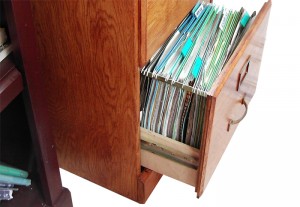by Caitlin Schwanger
Your filing system. It may be a big set of file drawers. It may be a small accordion-style folder. It may not even exist at all. Regardless of what it looks like, how big it is, or how organized it is (*cough cough*), we all know what goes in the files. Birth certificates, social security cards, marriage certificates, insurance policies, and so on.
It all seems so boring and impersonal, but our record-keeping systems are essential. What would happen if you didn’t have those important documents? It is never too early to start working on your record-keeping system.
Create a system that works for you. My husband and I keep our important papers together in an accordion folder. That’s all we need for now (although I’m excited for the day we’ll have an important-looking set of file drawers and color-coded folders). Categorize your documents in a way that’s logical to you, and keep it all in a safe place.
Don’t know what to save? Here is a list of important documents to help you get started:
- Tax returns for the past seven years
- Warranties for cars, appliances, tools, etc.
- Wage or salary pay records for seven years
- Insurance policies
- Bank records for the past seven years
- Medical receipts for seven years
- Credit card statements for seven years
- Deeds and titles
- Stock and bond certificates
- Debts you owe or are owed (adapted from Israelsen 2011, 51)
Some of us, including me, have some areas to improve in! For example, when you get your bank statement electronically, do you print it out? Start doing that, because they can get harder to access (sometimes even costing you money) as time goes on. Do you keep all your pay stubs? Hold on to those! Why seven years, you ask? That’s in case you ever get audited for taxes.
But this whole record-keeping thing still seems rather boring, cold, and impersonal, right? Think of this as your family’s record-keeping system. There’s more to records than financial statements and birth certificates. What about photos? journals? important letters? Saving personal records is just as essential and important.
Now, I’m not going to lecture on how we’re all supposed to be keeping a journal—I’ll let our consciences do that. I just want to emphasize how important it is to save these other important documents as well. You will be able to remember exciting family vacations with your photo albums, show your children pictures of great-grandparents they have never met, and share stories from your childhood with your children from your old, chicken-scratchy journals. These things will be important to your children! So do your best to save your records.
Here are some ideas of personal records you might want to start saving:
- Personal journals
- Treasured letters (or emails)
- Certificates of achievement
- Photo albums
- Selected examples of children’s artwork or schoolwork
- Home videos (adapted from Israelsen 2011, 51–52)
(On a side note, having all of your photos saved onto your computer is not good enough. One day, your computer will crash. Don’t lose your photos in that disaster. Save them to a disk, print them out—do something to keep them safe and saved forever.)
So, while you’re setting up your family’s filing system, don’t think of it as just a filing system, but as a record-keeping system. Make it personal!
The lists of items to save came from my workbook for SFL 260: Family Finance. Israelsen, Craig L. 2011. Personal and Family Finance Workbook. 6th ed. Provo, UT: BYU Academic Publishing.






